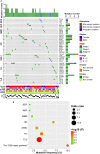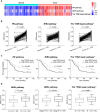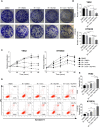A Comprehensive Analysis of Alterations in DNA Damage Repair Pathways Reveals a Potential Way to Enhance the Radio-Sensitivity of Esophageal Squamous Cell Cancer
- PMID: 33178606
- PMCID: PMC7596747
- DOI: 10.3389/fonc.2020.575711
A Comprehensive Analysis of Alterations in DNA Damage Repair Pathways Reveals a Potential Way to Enhance the Radio-Sensitivity of Esophageal Squamous Cell Cancer
Abstract
Esophageal squamous cell cancer (ESCC) is a common malignancy with a poor 5-year overall survival in China. Altered DNA damage repair (DDR) pathways are associated with a predisposition to cancer and contribute to therapeutic response and resistance in cancers. However, alterations of DDR pathway genes in ESCC are still largely unknown. In this study, we employed genome sequencing data of 192 samples, comparative genomic hybridization data of 123 cases, and gene expression microarray data of 119 patients to firstly perform a comprehensive analysis of the gene alterations of 7 DDR pathways in ESCC. Gene mutations and copy number variations (CNVs) were observed in all 7 DDR pathways, and especially, CNVs were the dominant alteration types. Compared with other pathways, two DNA double-strand break (DSB) repair pathways homologous recombination (HR) and non-homologous end joining (NHEJ), carried significant gene mutations and CNVs especially gene amplifications. Most genes including RAD54B, NBS1, RAD51B, and PRKDC were significantly amplified and over-expressed in ESCC. Amplification and high expression of DSB repair pathway genes were associated with poorer overall survival. Gene set variation analysis further showed that DSB repair pathways were up-regulated in ESCC. Besides, we firstly demonstrated that combination of mirin and NU7441, two inhibitors for HR and NHEJ respectively, with ionizing radiation treatment significantly enhanced DSBs, reduced clonogenic cell survival, inhibited cell proliferation, and promoted cell apoptosis in ESCC cells with DSB pathway gene amplification. These findings suggest that DSB repair pathways were significantly altered in ESCC and inhibiting DSB repair pathways might enhance the radio-sensitivity of ESCC with DSB repair up-regulation.
Keywords: DNA damage repair pathways; NU7441; esophageal squamous cell cancer; homologous recombination; mirin; non-homologous end joining; radio-sensitivity.
Copyright © 2020 Wang, Guo, Zhang, Li, Xu, Li, Wang and Zhan.
Figures







Similar articles
-
Impairment of the non-homologous end joining and homologous recombination pathways of DNA double strand break repair: Impact on spontaneous and radiation-induced mammary and intestinal tumour risk in Apc min/+ mice.DNA Repair (Amst). 2015 Nov;35:19-26. doi: 10.1016/j.dnarep.2015.08.002. Epub 2015 Sep 6. DNA Repair (Amst). 2015. PMID: 26435054
-
Inhibitory effects of valproic acid in DNA double-strand break repair after irradiation in esophageal squamous carcinoma cells.Oncol Rep. 2015 Sep;34(3):1185-92. doi: 10.3892/or.2015.4089. Epub 2015 Jun 26. Oncol Rep. 2015. PMID: 26135807
-
The effects of altered DNA damage repair genes on mutational processes and immune cell infiltration in esophageal squamous cell carcinoma.Cancer Med. 2023 Apr;12(8):10077-10090. doi: 10.1002/cam4.5663. Epub 2023 Jan 27. Cancer Med. 2023. PMID: 36708047 Free PMC article.
-
Regulation of repair pathway choice at two-ended DNA double-strand breaks.Mutat Res. 2017 Oct;803-805:51-55. doi: 10.1016/j.mrfmmm.2017.07.011. Epub 2017 Jul 29. Mutat Res. 2017. PMID: 28781144 Review.
-
Targeting DNA Double-Strand Break Repair Pathways to Improve Radiotherapy Response.Genes (Basel). 2019 Jan 4;10(1):25. doi: 10.3390/genes10010025. Genes (Basel). 2019. PMID: 30621219 Free PMC article. Review.
Cited by
-
Multi-omics characterization of esophageal squamous cell carcinoma identifies molecular subtypes and therapeutic targets.JCI Insight. 2024 Apr 23;9(10):e171916. doi: 10.1172/jci.insight.171916. JCI Insight. 2024. PMID: 38652547 Free PMC article.
-
Knockdown of long non-coding RNA SNHG8 suppresses the progression of esophageal cancer by regulating miR-1270/BACH1 axis.Bioengineered. 2022 Feb;13(2):3384-3394. doi: 10.1080/21655979.2021.2021064. Bioengineered. 2022. PMID: 35067159 Free PMC article.
-
Nuclear-Localized BCKDK Facilitates Homologous Recombination Repair to Support Breast Cancer Progression and Therapy Resistance.Adv Sci (Weinh). 2025 Jun;12(22):e2416590. doi: 10.1002/advs.202416590. Epub 2025 Apr 29. Adv Sci (Weinh). 2025. PMID: 40298908 Free PMC article.
-
Altered Signaling Pathways Revealed by Comprehensive Genomic Profiling in Patients With Unknown Primary Tumors.Front Oncol. 2022 Mar 24;12:753311. doi: 10.3389/fonc.2022.753311. eCollection 2022. Front Oncol. 2022. PMID: 35402276 Free PMC article.
-
Prognostic value of ubiquitination-related differentially expressed genes in esophageal squamous cell carcinoma: a comprehensive analysis and future directions.J Thorac Dis. 2024 Nov 30;16(11):7866-7884. doi: 10.21037/jtd-24-1863. Epub 2024 Nov 29. J Thorac Dis. 2024. PMID: 39678832 Free PMC article.
References
LinkOut - more resources
Full Text Sources
Research Materials
Miscellaneous

